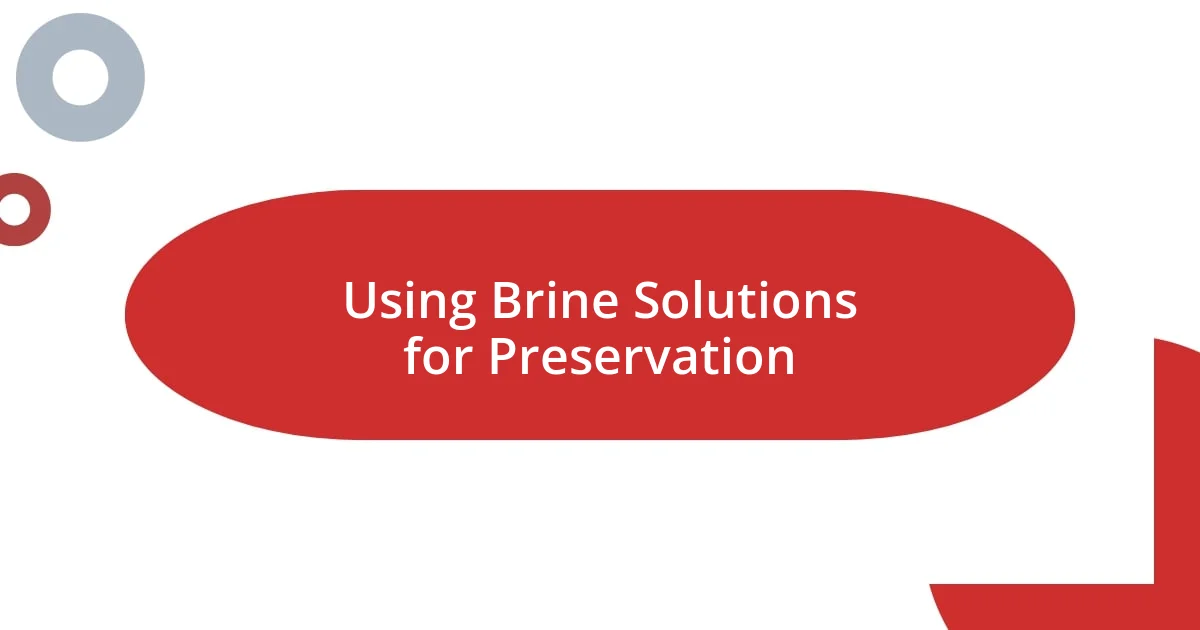Key takeaways:
- Different cheese preservation techniques significantly affect flavor and texture, with methods like vacuum sealing and salting proving particularly effective.
- Aging cheese enhances its flavor, with each variety reacting differently to the process, leading to unique taste experiences.
- Proper storage methods, such as using breathable wraps and maintaining consistent temperatures, are crucial for extending shelf life and preserving cheese quality.

Understanding Cheese Preservation Techniques
When it comes to preserving cheese, I’ve found that different techniques can significantly impact flavor and texture. For instance, I once refrigerated a wheel of Brie wrapped in wax paper and, to my surprise, it dried out more than I expected. This experience made me realize that the right packaging, like using cheese paper or breathable wraps, is just as crucial as temperature.
One method that intrigues me endlessly is the use of vacuum sealing. I had a friend who vacuum-sealed his homemade mozzarella. I never thought cheese could retain its fresh flavor for weeks longer! It got me wondering—have you ever considered how much longer your cheese could last using this technique? This experience really opened my eyes to the possibilities of extending shelf life without sacrificing taste.
Salting is another fascinating preservation technique that I’ve experimented with. I vividly remember preparing a batch of ricotta and adding salt at different levels. The results were astonishing—one version was delectably creamy, while the other, saltier one, had a concentrated flavor that transformed my pasta dishes. It got me pondering about how salt not only preserves but also enhances the cheese’s character!

Common Preservation Methods Explained
I’ve come to appreciate the diverse methods for preserving cheese, each carrying its own unique benefits. One classic approach is storing cheese in an airtight container in the fridge. I remember once accidentally leaving a batch of aged cheddar in its original packaging, only to find it had absorbed the odors of the fridge. It was an eye-opener for me—using a dedicated container made a world of difference, preventing that unfortunate flavor crossover.
Here are some common preservation methods:
- Refrigeration: Keeping cheese cold slows down spoilage, but be mindful of how it’s wrapped.
- Vacuum Sealing: This method removes air, helping to maintain flavor and extend freshness dramatically.
- Salting: Applying salt not only preserves but also intensifies certain flavors, creating a deliciously unique profile.
- Freezing: Though it can change texture, freezing can extend shelf-life significantly for certain cheeses.
- Aging: Some cheeses actually improve with time; a little patience can yield delicious rewards.
Through experimentation, I’ve realized that exploring these techniques can transform cheese preservation from a chore into a delightful culinary journey.

Vacuum Sealing for Cheese Freshness
Vacuum sealing has been a game changer for me in the realm of cheese preservation. After a delightful cheese tasting event at a local shop, I decided to buy a variety of cheeses to take home. I turned to vacuum sealing them, wondering if it could maintain that wonderful freshness I experienced. To my delight, when I unsealed them weeks later, they tasted just as vibrant as the day I bought them!
One time, I experimented with vacuum sealing a wedge of tangy goat cheese. I sealed it up and slipped it into my fridge, anticipating that it would last longer than if I’d just left it in its original packaging. When I finally pulled it out after a month, it was astounding—it was still creamy and delightful! This left me thinking about how the airless environment helped preserve its unique flavor profile. Have you ever had a cheese surprise like that?
The beauty of vacuum sealing is not just in extending the life of cheese but also in preserving its textures and flavors. I recall sealing a few portions of my favorite aged gouda. When I tasted it weeks later, the rich, nutty flavors hadn’t faded at all, as they might have in traditional wrapping. This technique truly shows how a little extra effort can lead to delicious rewards.
| Method | Advantage |
|---|---|
| Vacuum Sealing | Extends freshness and maintains flavor |
| Refrigeration | Slows spoilage but may affect flavor |
| Salting | Enhances flavor while preserving |
| Freezing | Greatly extends shelf life, but may alter texture |
| Aging | Improves flavor for certain cheeses |

Using Brine Solutions for Preservation
Using brine solutions for cheese preservation has been a fascinating journey for me. The first time I immersed some feta in a homemade brine, I was curious about how it would alter the flavor. To my joy, that salty elixir not only kept the cheese fresh for weeks but also infused it with a delightful tang. Have you ever tasted cheese that felt like a flavor explosion in your mouth? That’s what brining can do!
I remember preparing a batch of mozzarella with a simple saltwater solution. After soaking it for a couple of days, I tasted it, and the difference was incredible! The brine lent the mozzarella a savory depth that I had never experienced before. It made me wonder: how had I overlooked this method for so long? The texture remained wonderfully creamy, and the immersion truly elevated the overall experience.
There’s something deeply rewarding about using brine solutions. It feels like a blend of art and science, where the balance of salt and water can transform the character of the cheese. Plus, it’s surprisingly easy! You can whip up a batch in no time, and the results are nothing short of delicious. Why not give it a try and discover how a simple brine can take your cheese to the next level?

Aging Cheese for Better Flavor
Aging cheese, in my experience, is one of the most rewarding techniques you can embrace for flavor enhancement. I vividly recall the first time I tucked away a half-wheel of cheddar in my cheese fridge, letting it mature for a few months. When I finally unwrapped that aged beauty, the sharp, complex flavors burst in my mouth. It felt like the cheese had undergone a beautiful transformation, deepening its personality from mild to robust and utterly satisfying. Have you ever felt that thrill when finally tasting something you’ve patiently waited for?
What surprised me most about aging cheese is how each cheese reacts differently to the process. I experimented with a small piece of blue cheese, letting it sit longer than usual. Each week, I would peek at its developing aroma and texture. By the end of the aging period, that cheese had developed an intensely rich flavor, with layers that danced on my palate. It made me realize how aging can unlock the hidden potential in various cheeses, creating a unique tasting adventure. Could there be a hidden gem waiting for you in your cheese cave?
There’s definitely a particular joy in aging cheese at home. It’s like an ongoing relationship, nurturing and observing how time plays its game. I remember a batch of gouda that I aged for nearly six months—it became a labor of love. When I finally tasted it, the rich, nutty essence enveloped my senses. It’s moments like these that make me believe in the magic of patience and nature. If you haven’t tried it yet, I highly encourage you to explore the world of aging; you might just discover exceptional flavors you never knew existed!

Storing Cheese for Longevity
Storing cheese effectively is all about creating the right environment for it. I’ve experimented with various containers, and one of my favorite methods is using wax paper to wrap my cheese. It’s breathable, allowing the cheese to age gracefully without suffocating in plastic. Have you ever opened up a wrapped cheese that just didn’t taste right? That’s often because it didn’t get enough air or was stored improperly.
In my cheese journey, I’ve found that temperature plays a crucial role in longevity. I remember when I mistakenly left a wheel of brie on the counter, thinking it would be fine overnight. The next day, it was a melted mess! Since then, I’ve made a point to store my cheeses in the fridge, specifically in the vegetable drawer where the temperature is more stable. I’ve learned that maintaining consistent temperatures keeps flavors intact and prevents spoilage.
I also swear by using glass containers with minimal ventilation for softer cheeses. I once tried this with a creamy goat cheese I couldn’t resist bringing home. The glass not only kept it fresh for weeks but also allowed me to admire its lovely texture as it developed a subtle tang over time. Have you noticed how the right storage can elevate your cheese experience? It really makes a difference in preserving those delicious flavors, ensuring each bite is as delightful as intended.















